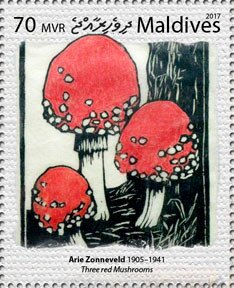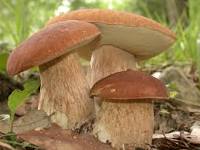Stamp: "Three Red Musrooms", by Arie Zonneveld (Maldives 2017)
"Three Red Musrooms", by Arie Zonneveld (Maldives 2017)
21 June (Maldives ) within release Paintings of Mushrooms goes into circulation Stamp "Three Red Musrooms", by Arie Zonneveld face value 70 Maldivian rufiyaa
| Stamp "Three Red Musrooms", by Arie Zonneveld in catalogues | |
|---|---|
| Michel: | Mi: MV 7152 |
Stamp is square format.
Stamp from souvenir sheet Issue acknowledged by the Maldive postal authorities, but only distributed by the Maldive philatelic agent for collecting purposes.Also in the issue Paintings of Mushrooms:
- Stamp - "Gnome House", by Fritz Baumgarten face value 22;
- Stamp - "Ex libris", by Gustaaf van de Wall Perné face value 22;
- Souvenir Sheet - Paintings of Mushrooms face value 70;
- Stamp - "Mushrooms" (1910), by William Aiken Walker face value 22;
- Mini Sheet - Paintings of Mushrooms face value 4*22;
- Stamp - "Three Red Musrooms", by Arie Zonneveld face value 70;
- Stamp - Various Mushrooms, by Edith Blackwell Holden face value 22;
Stamp "Three Red Musrooms", by Arie Zonneveld it reflects the thematic directions:
A mushroom (or toadstool) is the fleshy, spore-bearing fruiting body of a fungus, typically produced above ground on soil or on its food source. The standard for the name "mushroom" is the cultivated white button mushroom, Agaricus bisporus; hence the word "mushroom" is most often applied to those fungi (Basidiomycota, Agaricomycetes) that have a stem (stipe), a cap (pileus), and gills (lamellae, sing. lamella) on the underside of the cap. These gills produce microscopic spores that help the fungus spread across the ground or its occupant surface. "Mushroom" describes a variety of gilled fungi, with or without stems, and the term is used even more generally, to describe both the fleshy fruiting bodies of some Ascomycota and the woody or leathery fruiting bodies of some Basidiomycota, depending upon the context of the word. Forms deviating from the standard morphology usually have more specific names, such as "bolete", "puffball", "stinkhorn", and "morel", and gilled mushrooms themselves are often called "agarics" in reference to their similarity to Agaricus or their order Agaricales. By extension, the term "mushroom" can also designate the entire fungus when in culture; the thallus (called a mycelium) of species forming the fruiting bodies called mushrooms; or the species itself.
Painting is the practice of applying paint, pigment, color or other medium to a solid surface (support base). The medium is commonly applied to the base with a brush, but other implements, such as knives, sponges, and airbrushes, can be used. Painting is a mode of creative expression, and the forms are numerous. Drawing, gesture (as in gestural painting), composition, narration (as in narrative art), or abstraction (as in abstract art), among other aesthetic modes, may serve to manifest the expressive and conceptual intention of the practitioner. Paintings can be naturalistic and representational (as in a still life or landscape painting), photographic, abstract, narrative, symbolistic (as in Symbolist art), emotive (as in Expressionism), or political in nature (as in Artivism). A portion of the history of painting in both Eastern and Western art is dominated by spiritual motifs and ideas. Examples of this kind of painting range from artwork depicting mythological figures on pottery, to Biblical scenes rendered on the interior walls and ceiling of the Sistine Chapel, to scenes from the life of Buddha or other images of Eastern religious origin. In art, the term painting describes both the act and the result of the action. The support for paintings includes such surfaces as walls, paper, canvas, wood, glass, lacquer, clay, leaf, copper and concrete, and the painting may incorporate multiple other materials including sand, clay, paper, plaster, gold leaf, as well as objects. The term painting is also used outside of art as a common trade among craftsmen and builders.
Flora is the plant life occurring in a particular region or time, generally the naturally occurring or indigenous—native plant life. The corresponding term for animal life is fauna. Flora, fauna and other forms of life such as fungi are collectively referred to as biota. Sometimes bacteria and fungi are also referred to as flora, as in the terms gut flora or skin flora.



